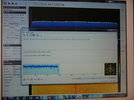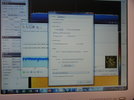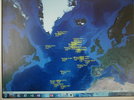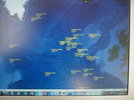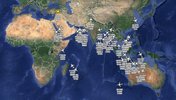I posted this to the PP group, it's aimed at users familiar with PP and air comms but not so experienced with satellite stuff, especially circular polarity on C-Band.
64E GES:C1 T channel = 1.533.820.000
64E GES:C1 T channel = 1.534.911.000
64E GES:C1 R channel = 1.534.397.000
64E GES:C1 R channel = 1.534.457.000
64E GES:C1 R channel = 1.533.804.000
64E GES:C5 T channel = 1.534.428.000
64E GES:C5 T channel = 1.533.866.000
64E GES:C5 R channel = 1.534.038.000
64E GES:C5 R channel = 1.534.413.000
64E GES:C5 R channel = 1.534.443.000
64E GES:C5 R channel = 1.533.880.000
25E GES:90 T channel = 1.526.013.000
25E GES:90 R channel = 1.525.999.000
25E GES:90 R channel = 1.526.026.000
25E GES:90 R channel = 1.526.228.000
25E GES:90 R channel = 1.526.243.000
25E GES:90 ? channel = 1.526.057.000 ?
25E GES:90 ? channel = 1.526.633.000 ?
25E GES:90 ? channel = 1.526.604.000 ?
25E GES:90 ? channel = 1.526.210.000 ?
15W GES:43 T channel = 1.534.434.000
15W GES:43 R channel = 1.533.857.000
15W GES:43 R channel = 1.534.403.000
15W GES:44 T channel = 1.533.887.000
15W GES:44 R channel = 1.534.419.000
15W GES:44 R channel = 1.533.901.000
15W GES:44 R channel = 1.533.872.000
54W GES:02 T channel = 1.533.864.000
54W GES:05 T channel = 1.533.894.000
54W GES:02 R channel = 1.533.909.000
54W GES:05 R Channel = 1.533.879.000
These are the four satellites I can see and all the channels I can decode on my 1.8M Prime Focus using a Titanium C1W LNB. The four question marked frequencies on 25E are too weak for good decoding on my dish. The ones of interest to Aero monitoring are marked as T channels, the others carry plenty of Aero traffic but no positioning reports.
I've listed the downconverted IF frequencies used to tune SDR Sharp, for the actual C-Band frequency subtract the given frequency from 5.150.000.000
Frequencies are liable to change a few kHz depending on external temperature effects on the LNB and receiver.
On my system which is set correctly for broadcast TV best results are obtained with left hand circular polarisation, this corresponds to the receiver being set to horizontal polarity. Note that rotating the depolarising plate in the LNB throat by 90° and switching the receiver to vertical will also give reception of LHCP. It is worth experimenting with this as many LNBs will have superior performance on one polarity.
As you move further away from due south circular polarity becomes less defined at least on both my systems and both polarities should be tried to ensure you're on the correct one.
I find it convenient to set all the T channels into memories using the frequency manager plugin for SDR Sharp. Another plugin called Aux VFO allows me to monitor multiple channels using virtual audio cable software and multiple instances of Jaero.
Unlike regular TV satellites Inmarsats are on inclined orbits which means they drift above and below their correct position in the Clarke Belt in a figure of eight movement. Once each satellite moves more than about 1° above or below the arc the signals will start to decrease so ideally the dish should be re-adjusted to match the change in elevation. These links will plot in real time where each of the four satellites are in relation to the arc, the exact value is given by its latitude.
64.5E Inmarsat 3-F1. Max inclination 3.1°
Real time satellite tracking for: INMARSAT 3-F1
25E Alphasat (Inmarsat 4A-F4). Max inclination 1.2°
Real time satellite tracking for: ALPHASAT (INMARSAT 4A-F4)
15W Inmarsat 3-F2. Max inclination 1.7°
Real time satellite tracking for: INMARSAT 3-F2
54W Inmarsat 3-F4. Max inclination 5.0°
Real time satellite tracking for: INMARSAT 3-F4
